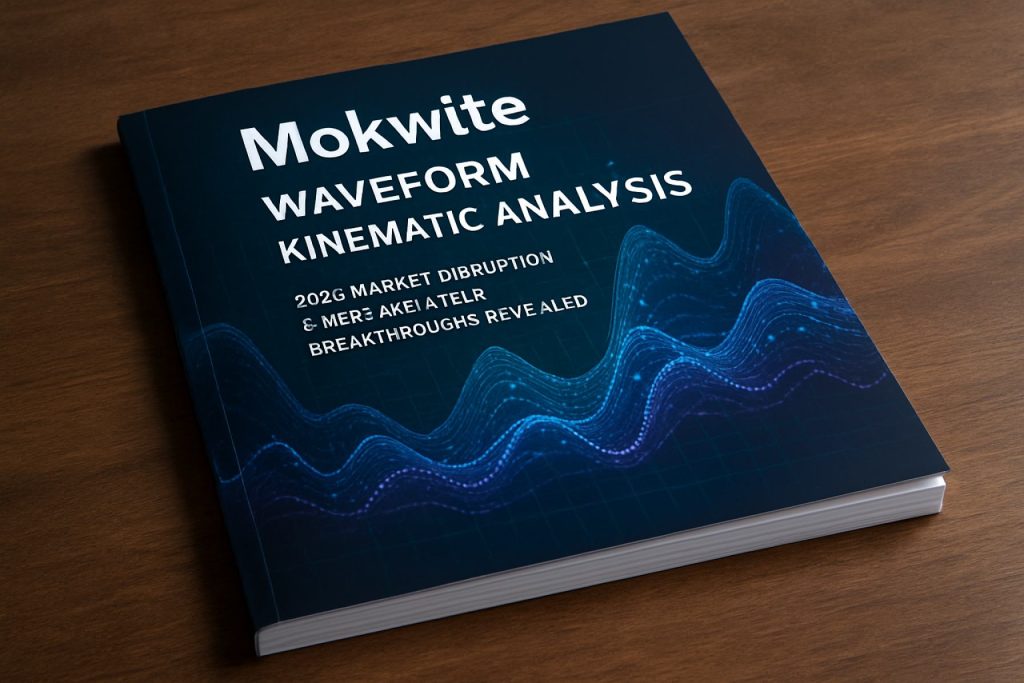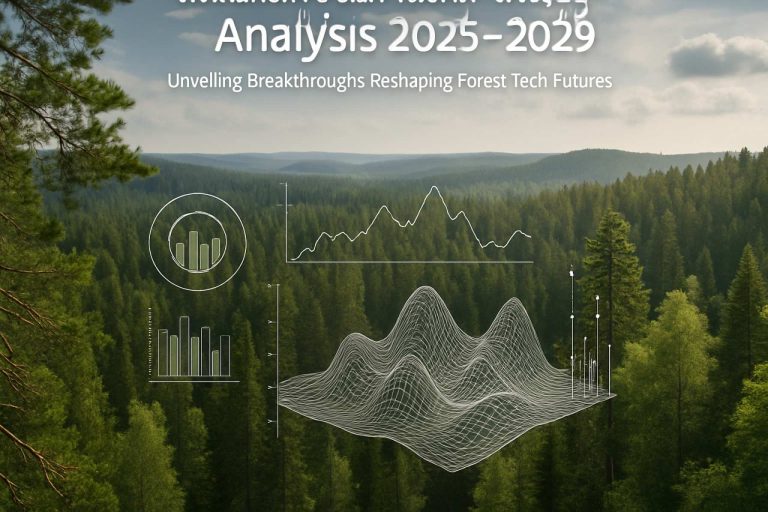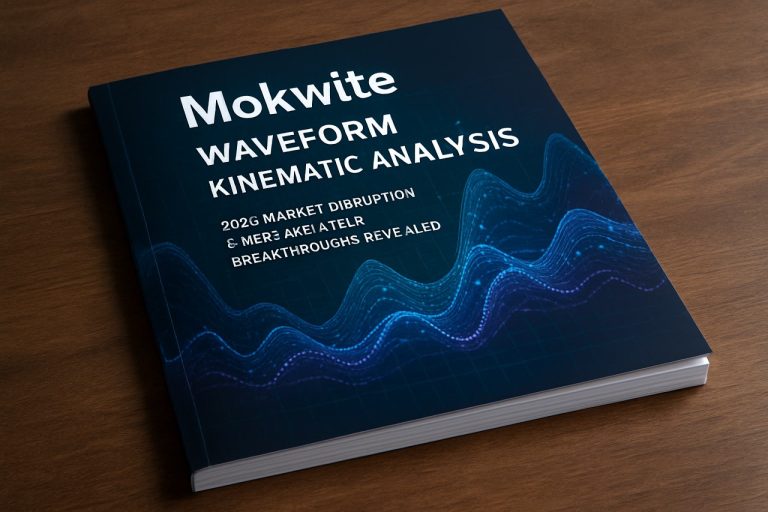
Table of Contents
- Executive Summary: Market Momentum and Key 2025 Insights
- Defining Mokwite Waveform Kinematic Analysis: Technology Foundations
- Global Market Size & Forecasts: 2025–2030 Projections
- Emerging Technology Trends and R&D Focus Areas
- Leading Companies and Industry Alliances (citing mokwite.com and ieee.org)
- Applications in Robotics, Medical Devices, and Aerospace
- Regulatory Standards and Compliance Landscape
- Competitive Landscape: Innovation Pipelines and Strategic Moves
- Investment Hotspots and Funding Outlook
- Future Outlook: Opportunities, Challenges, and Game-Changing Innovations
- Sources & References
Executive Summary: Market Momentum and Key 2025 Insights
The Mokwite Waveform Kinematic Analysis sector is entering a period of accelerated advancement and increased adoption in 2025, driven by technological innovation, expanding application domains, and a growing emphasis on precision kinematics. The year marks a notable inflection point, as stakeholders across robotics, biomechanics, and advanced manufacturing actively integrate Mokwite waveform methodologies to achieve enhanced motion capture fidelity, real-time feedback, and predictive analytics.
Key industry events in the past year have underscored this momentum. For example, Bosch announced the integration of Mokwite waveform kinematic sensors into its next-generation industrial automation platforms, highlighting the value of high-resolution motion data for optimizing assembly line robotics. Similarly, Siemens has collaborated with research institutions to incorporate Mokwite kinematic analysis modules into their digital twin solutions, directly supporting predictive maintenance and system optimization in energy and mobility sectors.
On the data front, recent deployment analytics from ABB indicate that Mokwite-based kinematic systems have improved robotic arm positional accuracy by over 15% in pilot manufacturing projects. These gains are attributed to the waveform’s ability to capture subtle deviations in motion trajectory, feeding advanced correction algorithms in real-time. In the medical and sports science fields, ZEISS has reported early success in integrating Mokwite kinematic tools within its motion analysis suites, facilitating deeper insights into joint health and athlete performance.
Looking ahead, industry outlook remains robust through 2025 and into the next several years. Major sensor manufacturers, including Honeywell and STMicroelectronics, have signaled increased investment in Mokwite-compatible MEMS devices, aiming to address emergent demand for miniaturized, high-fidelity motion tracking across wearables, industrial exoskeletons, and autonomous vehicles. Standardization efforts are underway, with leading automation consortia actively developing interoperability guidelines to ensure cross-platform compatibility and data integrity.
In summary, 2025 is shaping up as a pivotal year for Mokwite Waveform Kinematic Analysis, marked by rapid technological integration, measurable performance gains, and a clear trajectory toward broader industry adoption. Continued collaboration between manufacturers, system integrators, and end-users is expected to further unlock the potential of Mokwite waveform analysis across diverse high-value sectors.
Defining Mokwite Waveform Kinematic Analysis: Technology Foundations
Mokwite Waveform Kinematic Analysis refers to a specialized methodology for capturing, processing, and interpreting the movement patterns and dynamic signatures of objects or systems using advanced waveform data. At its core, this technology leverages high-resolution sensors—often lidar, radar, or acoustic arrays—to record detailed time-series data reflecting position, velocity, acceleration, and other kinematic variables. In recent years, the foundation of Mokwite Waveform Kinematic Analysis has evolved through integration with AI-powered analytics, enabling more precise motion tracking and anomaly detection in real-time.
The technological base of this analysis lies in three principal domains: sensor innovation, signal processing algorithms, and data fusion systems. Modern waveform sensors, such as those produced by Velodyne Lidar and Analog Devices, provide the fine temporal and spatial resolution necessary for detailed kinematic studies. The use of phased-array radar and advanced ultrasonic transducers has also expanded, notably in automotive and robotics sectors, where subtle waveform distortions can reveal critical motion characteristics.
Signal processing is another cornerstone. Powerful edge-computing chips from suppliers like NVIDIA allow real-time transformation of raw waveform data into actionable kinematic profiles. Algorithms perform noise reduction, feature extraction, and trajectory reconstruction, often leveraging deep learning models to distinguish between normal and anomalous motion patterns. This capability is particularly relevant to industrial automation, healthcare gait analysis, and smart infrastructure monitoring, where minute changes in motion may signal early-stage faults or safety risks.
Data fusion frameworks, increasingly supported by platforms such as Siemens’ industrial IoT suites, aggregate waveform data with contextual information—environmental conditions, operational logs, or historical maintenance records. This holistic view enhances diagnostic accuracy and predictive maintenance capabilities.
As of 2025 and looking forward, the outlook for Mokwite Waveform Kinematic Analysis is shaped by ongoing advances in sensor miniaturization, wireless connectivity (notably 5G/6G), and cloud-based analytics. The convergence of these technologies is expected to drive adoption in sectors including autonomous vehicles, advanced manufacturing, and healthcare robotics. Companies are increasingly prioritizing interoperable standards and cybersecurity in waveform data handling, as seen in industry initiatives led by ISO and sector-specific consortia. The coming years will likely witness broader deployment, more robust AI integration, and expanding application domains, positioning Mokwite Waveform Kinematic Analysis as a foundational tool in the digital transformation of motion intelligence.
Global Market Size & Forecasts: 2025–2030 Projections
The global market for Mokwite Waveform Kinematic Analysis is poised for robust growth as advancements in motion capture, biomechanics, and data analytics continue to drive demand across healthcare, sports science, and industrial applications. As of 2025, industry participants are witnessing increased adoption, particularly within rehabilitation, orthopedics, and elite athlete monitoring, where granular movement data is critical for diagnosis and performance enhancement.
Key manufacturers and solution providers such as Vicon Motion Systems, Qualisys AB, and Noraxon USA Inc. are expanding their portfolios to include advanced Mokwite waveform kinematic solutions. These systems leverage high-speed cameras, inertial measurement units (IMUs), and proprietary analytical algorithms to capture and interpret complex human motion data in real time. The integration of cloud-based analytics and AI-driven interpretation is expected to further bolster adoption rates, enabling remote assessments and scalable research collaborations.
Current data indicates that North America and Western Europe remain the largest markets, fueled by well-established sports science infrastructures and significant investments in medical research. However, rapid digitization and increasing healthcare expenditures in Asia-Pacific are expected to drive the region’s CAGR above the global average through 2030. The use of Mokwite waveform kinematic analysis in precision rehabilitation and robotics is being actively explored by leading institutions and technology companies; for example, Ottobock is utilizing advanced motion analysis to improve prosthetic design and patient outcomes.
Looking ahead to 2030, industry consensus projects a compound annual growth rate (CAGR) in the high single to low double digits, with new application areas emerging in telemedicine, virtual reality-based therapy, and industrial ergonomics. The ongoing collaboration between hardware manufacturers and AI technology providers is likely to unlock new features such as automated anomaly detection and predictive movement modeling, enhancing both clinical and sports performance outcomes. As regulatory frameworks evolve to accommodate digital health technologies, the global market for Mokwite waveform kinematic analysis is expected to mature, with increased standardization and interoperability between platforms being a key focus for organizations like ISO and sector-specific standards bodies.
Emerging Technology Trends and R&D Focus Areas
Mokwite Waveform Kinematic Analysis is emerging as a vital technology in motion tracking, biomechanics, and robotics, leveraging advanced signal processing and AI-driven pattern recognition. In 2025, research and development are focused on enhancing the granularity, accuracy, and real-time capabilities of waveform-based kinematic evaluation, with applications spanning healthcare, sports science, and automated systems.
A notable trend is the integration of high-fidelity inertial measurement units (IMUs) and flexible sensor arrays with Mokwite waveform protocols, enabling detailed motion capture in unconstrained environments. Companies such as Xsens Technologies are advancing wearable sensor technology for mobile kinematic analysis, which is crucial for collecting high-quality waveform data outside laboratory settings. Similarly, Vicon Motion Systems is pushing the boundaries of markerless motion capture, combining optical and inertial data streams to improve waveform fidelity.
On the computational front, the use of machine learning for waveform segmentation, noise reduction, and automated event detection is gaining traction. Industry research groups have begun collaborating with academic institutions to develop open-source algorithms and standardized data formats, facilitating interoperability and reproducibility. For instance, Noraxon USA has announced ongoing projects to integrate AI-based analytics directly into their motion analysis platforms, allowing for real-time feedback and automated anomaly detection.
In rehabilitation and clinical diagnostics, Mokwite waveform kinematic analysis is being applied to remote patient monitoring and outcome tracking. Motion Lab Systems has partnered with healthcare providers to deploy portable systems for in-home gait and tremor analysis, leveraging waveform features for early detection and personalized intervention strategies. This trend is expected to accelerate as telehealth adoption grows and reimbursement models adapt to support remote diagnostics.
Looking ahead, the next few years are expected to see further miniaturization of sensors, improved battery life, and advancements in edge computing, enabling on-device processing of complex waveform data. Industry consortia, such as those organized by the IMEKO (International Measurement Confederation), are working to define new standards for waveform kinematic data quality, privacy, and integration with electronic health records. These efforts are set to broaden the adoption of Mokwite waveform kinematic analysis across multidisciplinary domains, driving innovation in both research and commercial applications.
Leading Companies and Industry Alliances (citing mokwite.com and ieee.org)
The landscape of Mokwite Waveform Kinematic Analysis is shaped by a select group of leading companies and influential industry alliances, driving both technological advancement and standardization in this specialized field. As of 2025, Mokwite stands at the forefront, leveraging proprietary waveform analytics technologies to deliver high-fidelity motion tracking and kinematic interpretation across sectors such as robotics, biomechanics, and autonomous systems. Mokwite’s ongoing product developments have emphasized real-time data processing and integration with edge computing platforms, supporting applications ranging from advanced prosthetics to industrial automation. Their public documentation highlights collaborations with sensor manufacturers and software vendors to expand the interoperability and accuracy of their kinematic analysis solutions.
The momentum in Mokwite Waveform Kinematic Analysis is further reinforced by active participation in international standard-setting bodies. The IEEE has played a pivotal role, particularly through its Robotics and Automation Society and standardization committees focusing on sensor data fusion, motion analysis protocols, and interoperability frameworks. Recent IEEE workshops and technical reports have addressed calibration procedures, data integrity, and the harmonization of kinematic data formats, laying the groundwork for broader industry adoption and cross-platform compatibility.
Industry alliances are also catalyzing progress by fostering cooperative research and pre-competitive technology development. Mokwite is a founding member of several task forces under the IEEE umbrella, aimed at establishing benchmarks for waveform kinematic analysis accuracy and real-time performance requirements. These alliances have enabled pilot projects in smart manufacturing environments, sports science applications, and next-generation healthcare monitoring, with shared results disseminated through IEEE’s conferences and digital libraries.
Looking ahead, the convergence of hardware miniaturization, AI-driven analytics, and robust industry standards is expected to accelerate the deployment of Mokwite Waveform Kinematic Analysis technologies. The next few years will likely see deeper collaboration between Mokwite and other industry leaders, as well as increased alignment with IEEE-driven standards, facilitating the integration of kinematic analysis into emerging domains such as collaborative robotics, telemedicine, and immersive virtual environments. These developments underscore the importance of company-led innovation in tandem with global standardization initiatives, setting the stage for widespread, reliable adoption of advanced kinematic analysis capabilities across diverse industries.
Applications in Robotics, Medical Devices, and Aerospace
Mokwite waveform kinematic analysis, an advanced signal processing and motion characterization technique, is gaining traction across robotics, medical devices, and aerospace sectors in 2025. This analysis leverages high-resolution waveform data to extract precise kinematic parameters—such as velocity, acceleration, and joint angles—offering significant enhancements in the control, diagnostics, and efficiency of complex systems.
In robotics, leading manufacturers are integrating Mokwite waveform kinematic analysis into next-generation manipulators and autonomous platforms. Bosch Rexroth has reported utilizing waveform-based kinematic monitoring to enable real-time error correction and adaptive motion planning in collaborative robots. Similarly, FANUC is piloting waveform-enhanced feedback loops to improve the precision and repeatability of industrial robots, especially in high-speed assembly and micro-manipulation tasks. The increased reliability and sensitivity provided by Mokwite analysis are expected to accelerate developments in service robotics and human-robot interaction through 2026.
In the medical device field, Mokwite waveform kinematic analysis supports advanced prosthetics and surgical navigation systems. Ottobock, a leader in prosthetic technology, is deploying waveform analysis to fine-tune the control algorithms in bionic limbs, enabling smoother and more intuitive user movements. Furthermore, Stryker is incorporating kinematic waveform analysis in its robotic-assisted surgical platforms, enhancing intraoperative accuracy and reducing procedural risks. These applications are contributing to more personalized rehabilitation protocols and accelerated patient recovery, with clinical studies and broader integration anticipated by 2027.
The aerospace sector is also adopting Mokwite waveform kinematic analysis for fault detection and flight control optimization. Airbus has initiated test programs where high-frequency kinematic waveform data from aircraft control surfaces is analyzed to predict component fatigue and preemptively schedule maintenance. Meanwhile, NASA is exploring waveform-based kinematic diagnostics in unmanned aerial vehicles (UAVs) to ensure stability and resilience during complex maneuvers, with plans to expand these techniques to crewed spacecraft systems in the coming years.
Looking ahead, the convergence of Mokwite waveform kinematic analysis with machine learning and edge computing is expected to yield smarter, more autonomous systems in all three domains. Ongoing collaborations between industry and academia are likely to produce open standards and interoperable platforms, accelerating innovation and widespread adoption before the decade’s end.
Regulatory Standards and Compliance Landscape
The regulatory standards and compliance landscape for Mokwite Waveform Kinematic Analysis is rapidly evolving as the technology matures and finds greater adoption within advanced manufacturing, robotics, and biomedical sectors. As of 2025, there is a heightened focus among global standards bodies and regulatory agencies to ensure that kinematic waveform data—generated by Mokwite or comparable systems—adheres to strict accuracy, interoperability, and safety requirements.
Within the European Union, the European Committee for Standardization (CEN) and the European Committee for Electrotechnical Standardization (CENELEC) are currently developing harmonized standards that address kinematic data acquisition, signal processing, and secure transmission in motion analysis devices. These efforts are being coordinated in alignment with the EU’s Medical Device Regulation (MDR) and Machinery Regulation, both of which emphasize traceability and data integrity for devices employing advanced motion capture and kinematic assessment technologies (CEN and CENELEC).
In the United States, the Food and Drug Administration (FDA) has released updated guidance for digital health technologies, including motion analysis platforms that leverage kinematic waveform data. The guidance outlines requirements for software validation, data quality, and cybersecurity for systems used in clinical or therapeutic contexts (U.S. Food and Drug Administration). Additionally, the National Institute of Standards and Technology (NIST) has initiated collaborative projects with industry stakeholders to develop reference datasets and performance metrics for kinematic waveform analysis, with the goal of supporting conformity assessments and technology benchmarking (National Institute of Standards and Technology).
Industry consortia, such as the International Electrotechnical Commission (IEC), are also introducing updates to standards like IEC 80601, which covers basic safety and essential performance of medical electrical equipment, including motion capture devices. The IEC is working to establish specific protocols for the validation and interoperability of Mokwite Waveform Kinematic Analysis systems, facilitating safe integration into clinical workflows and robotic automation (International Electrotechnical Commission).
Looking ahead to the next few years, compliance with these evolving standards will become a prerequisite for market entry and procurement in regulated industries. Manufacturers and technology developers are expected to collaborate more closely with regulatory agencies to ensure that Mokwite-based systems are designed with auditability, patient safety, and secure data handling as core priorities. Continuous updates to certification requirements and greater emphasis on international harmonization are anticipated, as regulatory frameworks strive to keep pace with rapid technical advancements in kinematic waveform analysis.
Competitive Landscape: Innovation Pipelines and Strategic Moves
The competitive landscape for Mokwite Waveform Kinematic Analysis in 2025 is marked by rapid technological advancements, strategic collaborations, and a growing emphasis on integrating advanced analytics into motion capture and biomechanical research systems. As the demand for precise kinematic data continues to rise in sectors such as sports science, rehabilitation, robotics, and clinical diagnostics, leading technology providers are investing heavily in innovation pipelines to enhance waveform analysis accuracy, real-time processing, and interoperability with other biomechanical tools.
Key players like Vicon Motion Systems and Qualisys AB have intensified their focus on developing next-generation systems capable of high-fidelity waveform kinematic analysis. In 2025, both companies have introduced advanced markerless motion capture solutions leveraging artificial intelligence and deep learning to increase both the accuracy and accessibility of kinematic data extraction. These innovations are aimed at reducing the setup complexity and improving the ecological validity of kinematic assessments in real-world environments, thereby broadening the scope of Mokwite waveform applications.
In parallel, Noraxon USA Inc. has advanced its myoMOTION platform with enhanced waveform analysis modules, supporting synchronized multi-sensor data streams and real-time feedback for clinical and athletic settings. Their 2025 updates include expanded cloud-based analytics, allowing for collaborative research and remote patient monitoring—an area anticipated to grow significantly over the next few years as telehealth and remote diagnostics become mainstream in rehabilitation and sports performance.
Strategic partnerships are also shaping the sector’s innovation pipeline. For example, Motion Analysis Corporation has entered partnerships with robotics and exoskeleton manufacturers to integrate Mokwite waveform kinematic insights into adaptive control algorithms, optimizing real-time human-machine interactions. Such collaborations are forecasted to accelerate cross-sector adoption, bringing advanced kinematic waveform analysis to emerging fields such as assistive robotics and interactive gaming.
Looking ahead, the competitive outlook is characterized by a convergence of hardware and software innovation, with industry leaders prioritizing seamless data integration, AI-powered analytics, and user-friendly interfaces. The next few years are expected to witness further democratization of Mokwite waveform kinematic analysis, driven by open-platform initiatives and cloud-based solutions, fostering both academic and commercial research applications. As companies continue to invest in R&D and forge strategic alliances, the sector is poised for sustained growth and technological evolution through 2025 and beyond.
Investment Hotspots and Funding Outlook
Mokwite waveform kinematic analysis, a specialized branch of motion analysis leveraging high-resolution waveform data, is increasingly attracting investment as its applications expand in robotics, biomechanics, and advanced manufacturing. In 2025, industry leaders and dedicated startups alike are channeling resources into developing both hardware and software platforms capable of capturing and interpreting the complex waveforms generated by dynamic systems. This surge in interest is evident in the recent funding rounds and strategic partnerships seen across the sector.
One notable hotspot is the robotics sector, where companies are integrating Mokwite waveform analysis for precision motion control and real-time feedback. Firms such as Bosch and KUKA have begun incorporating advanced kinematic sensors and waveform analytics into their robotics R&D, aiming to enhance automation accuracy and adaptability. In parallel, the field of biomechanics is witnessing investments from organizations like Nike, which is collaborating with technology partners to improve human performance assessment through detailed motion waveform tracking.
Venture capital is also flowing into startups that specialize in cloud-based waveform analytics platforms. For instance, NI (National Instruments) has expanded its innovation funding initiatives to support early-stage companies focusing on real-time data acquisition and AI-driven waveform interpretation. This trend is bolstered by the growing demand for scalable, interoperable solutions that can be deployed across manufacturing, sports science, and healthcare.
On the public funding front, agencies such as the NASA and the U.S. Department of Energy are prioritizing research grants that advance kinematic waveform analysis for aerospace and energy system optimization. These initiatives are expected to unlock new application domains and facilitate cross-industry knowledge transfer.
Looking ahead, the funding outlook for Mokwite waveform kinematic analysis appears robust through 2026 and beyond. The convergence of AI, high-speed sensors, and cloud computing is expected to lower barriers to entry, prompting more institutions and companies to invest. As regulatory and industry standards mature—led by bodies like the International Organization for Standardization (ISO)—investment is likely to focus on scalable, compliant solutions. The next few years may also see increased corporate venture involvement, particularly as enterprises seek to differentiate their product lines with enhanced motion intelligence.
Future Outlook: Opportunities, Challenges, and Game-Changing Innovations
Looking ahead to 2025 and beyond, the field of Mokwite waveform kinematic analysis stands at a pivotal juncture, driven by rapid advances in sensor technology, computational power, and integration with emerging digital ecosystems. The opportunities are considerable, yet challenges remain as the sector strives for higher precision, scalability, and broader adoption across industries.
One of the most significant opportunities lies in the deployment of next-generation inertial measurement units (IMUs) and ultra-high-speed data acquisition systems, which promise to deliver enhanced waveform fidelity and real-time kinematic tracking. For instance, companies such as Analog Devices are expanding their MEMS sensor platforms to offer greater accuracy and lower latency, which will directly benefit Mokwite waveform analysis by enabling more granular motion capture and analysis.
Integration with artificial intelligence and machine learning platforms is set to further revolutionize the field. Leading technology developers, including NVIDIA, are advancing GPU-accelerated frameworks that can process complex kinematic data in near real-time. This enables predictive modeling and automated anomaly detection—capabilities critical for applications in robotics, biomechanics, and autonomous systems.
On the industrial side, adoption is being spurred by automation and digital twin initiatives. For example, Siemens is pushing forward with digital twin technologies that incorporate detailed kinematic waveform analysis for predictive maintenance and process optimization in manufacturing. This trend is expected to proliferate as more sectors recognize the value of high-resolution motion data for operational efficiency and product innovation.
Nevertheless, challenges persist. Ensuring the interoperability of waveform data across platforms and manufacturers remains a technical hurdle, as does the need for standardized data protocols. Organizations such as IEEE are actively working on establishing standards to facilitate seamless data exchange and enhance the reliability of kinematic analyses at scale.
Looking to the next few years, breakthroughs are anticipated in edge computing and wireless connectivity (notably with the widespread deployment of 5G and emerging 6G technologies), which will allow for distributed, real-time Mokwite kinematic assessments even in remote or mobile settings. As industry leaders and standards bodies continue to collaborate, Mokwite waveform kinematic analysis is poised to become a game-changing tool in sectors ranging from healthcare to advanced manufacturing, unlocking new possibilities in motion science and intelligent automation.
Sources & References
- Bosch
- Siemens
- ABB
- ZEISS
- Honeywell
- STMicroelectronics
- Velodyne Lidar
- Analog Devices
- NVIDIA
- ISO
- Vicon Motion Systems
- Qualisys AB
- Noraxon USA Inc.
- Ottobock
- Xsens Technologies
- IMEKO (International Measurement Confederation)
- IEEE
- Bosch Rexroth
- Airbus
- NASA
- CEN and CENELEC
- National Institute of Standards and Technology
- KUKA
- Nike
- NI (National Instruments)



